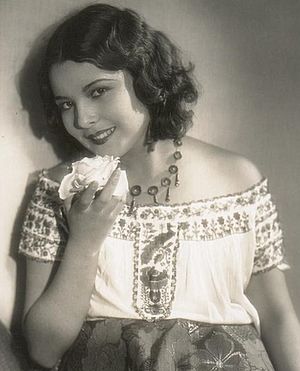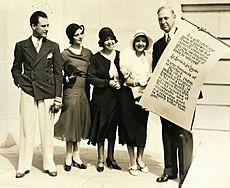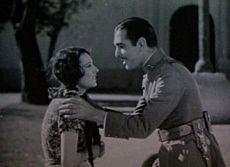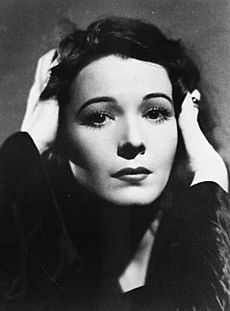Lupita Tovar facts for kids
Quick facts for kids
Lupita Tovar
|
|
|---|---|

Tovar, c. 1930s
|
|
| Born |
Guadalupe Natalia Tovar Sullivan
27 July 1910 |
| Died | 12 November 2016 (aged 106) Los Angeles, California, U.S.
|
| Resting place | Hillside Memorial Park Cemetery |
| Other names | Lupita Kohner |
| Occupation | Actress |
| Years active | 1929–1945 |
|
Notable work
|
Drácula Santa |
| Spouse(s) |
Paul Kohner
(m. 1932; died 1988) |
| Children | 2; including Susan Kohner |
| Relatives | Frederick Kohner (brother‑in‑law) John Weitz (son-in-law) Paul Weitz (grandson) Chris Weitz (grandson) |
| Signature | |
 |
|
Guadalupe Natalia Tovar Sullivan (born July 27, 1910 – died November 12, 2016), known as Lupita Tovar, was an actress from Mexico. She was famous for her main role in the 1931 Spanish version of Drácula. This movie was filmed in Los Angeles at night. It used the same sets as the English version with Béla Lugosi, but had different actors and a different director.
Lupita Tovar also starred in the 1932 film Santa. This was one of the first Mexican sound films. It was also one of the first Spanish-language sound films made for a wide audience. When she passed away, she was the oldest living actress. She was also one of the last stars from the Golden Age of Mexican cinema and the Golden Age of Hollywood.
Contents
Early Life
Lupita Tovar was born in Matías Romero, Oaxaca, Mexico. Her father, Egidio Tovar, was from Tehuacán, Mexico. Her mother, Mary Tovar, was Irish-Mexican and from Matías Romero. Lupita was the oldest of nine children. She grew up during the Mexican Revolution, and her family was very poor. She was raised in a very religious Catholic family and went to a school run by nuns.
In 1918, Lupita's family moved to Mexico City. Her father worked there for the National Railroad of Mexico in an office job.
Career in Movies
Starting Out

Lupita Tovar was discovered by filmmaker Robert J. Flaherty in Mexico City. She had taken a dance class and was invited to try out for a movie. Lupita won first place in the competition. Her prize was a chance to work for Fox Studios for six months. After that, she could get a seven-year contract.
Studios realized they could make more money by filming Spanish versions of English movies at the same time. So, they looked for Spanish-speaking stars. Lupita moved to Hollywood in November 1928 with her grandmother.
When she was under contract, Lupita had to study a lot for her film roles. Every week, she spent hours learning guitar, Spanish dances, acting, and English. Her Spanish accent was actually helpful for "talkies," which were movies with sound. Her English got much better in just seven months. She learned new words by watching movies and reading many books. In 1929, Tovar appeared in films like The Veiled Woman and The Cock-Eyed World.
Spanish Versions of Films
Lupita's future husband, producer Paul Kohner, had an idea. He convinced Carl Laemmle to make Spanish-language movies. These could be filmed at night, using the same sets as the English versions filmed during the day.
When sound films became popular, Lupita was told her English wasn't good enough. But she was advised to try working in the foreign film department. She met Paul Kohner, who offered her a job. She would earn $15 a day to dub films into Spanish. Her first dubbing job was for The King of Jazz.
In 1930, Tovar starred with Antonio Moreno in La Voluntad del Muerto. This was the Spanish version of The Cat Creeps. Both films were remakes of an earlier movie called The Cat and the Canary. The Spanish version was filmed at night, just like the Spanish Drácula.
Lupita filmed Drácula in 1930 when she was 20 years old. Her future husband, Paul Kohner, produced the movie.
Santa
In 1932, Tovar starred in the film Santa. This movie was special because it was the first to have sound and picture recorded together on the same film strip in Mexico.
Santa was a huge success. The Mexican government even made a postage stamp with Lupita Tovar as Santa on it. Lupita said, "I couldn't walk on the streets when Santa came out. People tore my dress for souvenirs. It was something!"
In 2006, Santa was shown at a special event by the Academy of Motion Picture Arts and Sciences. It was called "A Salute to Lupita Tovar." Lupita talked about her career with film historian Bob Dickson. The event honored her amazing work.
Personal Life
Lupita Tovar was called "Lupita" by everyone since she was a child.
While filming Santa, producer Paul Kohner had to go back to Europe. This time apart made Lupita realize she loved him. Kohner proposed to her over the phone. They got married in Czechoslovakia on October 30, 1932. The wedding took place at Kohner's parents' home.
In 1936, they had a daughter named Susan Kohner. Susan later became a film and TV actress. In 1939, they had a son, Paul Julius "Pancho" Kohner Jr. Their grandsons, Chris and Paul Weitz, are also successful film directors.
In the early 1990s, the Spanish-language Drácula was released on home video. This made Lupita Tovar's films popular again. She said, "It's like a dream being invited to all of these festivals and showings of my films. Was that really me up there on the screen? I had almost forgotten I was an actress. It has been absolutely wonderful how people have been so nice. Usually people die and then they get the award, but to be alive and receive this honor is fantastic!"
Death
Lupita Tovar passed away on November 12, 2016, in Los Angeles. She was 106 years old. She died of heart disease, just one day after her daughter Susan Kohner's 80th birthday.
Awards
- 2001: Academia Mexicana de Artes y Ciencias Cinematográficas (Mexican Academy of Arts and Sciences), Lifetime Achievement Award. She received the Ariel de Oro.
Images for kids
See also
 In Spanish: Lupita Tovar para niños
In Spanish: Lupita Tovar para niños
- Cinema of Mexico






